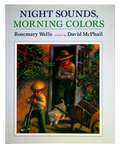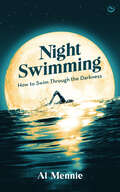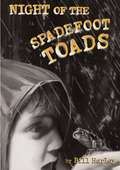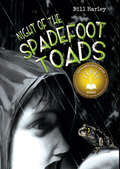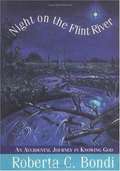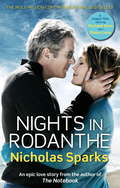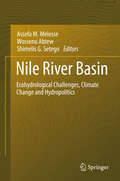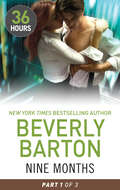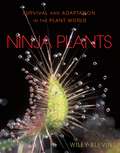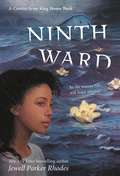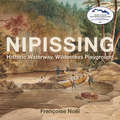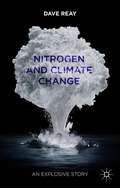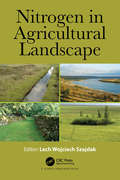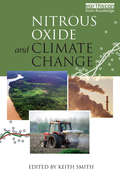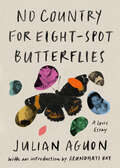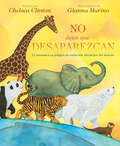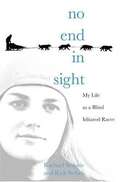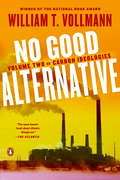- Table View
- List View
Night Sky: A Falcon Field Guide
by Nicholas NigroThe ultimate illustrated guide to the most spectacular objects in the night sky, fully updated and revised.Night Sky: A Falcon Field Guide covers summer and winter constellations, planets, and stars found in the northern hemisphere. Conveniently sized to fit in a pocket and featuring detailed photographs, this informative guide makes it easy to identify objects in the night sky even from one&’s own backyard. From information on optimal weather conditions, preferred viewing locations, and how to use key tools of the trade, this handbook will help you adeptly navigate to and fro the vast and dynamic nighttime skies, and you&’ll fast recognize that the night sky&’s the limit.
Night Sounds, Morning Colors
by Rosemary WellsA child explores the senses by reflecting on experiences associated with the seasons.
Night Swimming: How to swim through the darkness
by Al MennieFor wild swimmers and those wishing to deepen their nature connection, this is the first book on the wellbeing benefits of night swimming, from international big wave surfer Al Mennie.Discover the unmatched beauty of wild swimming by night. Combining motivational writing with evocative storytelling, international big wave surfer and night swimmer Al Mennie gives readers the tools to discover their own methods of navigating through darkness to find clarity and focus.Weaving together swim stories with the practicalities of how and when he swims at night, along with the benefits that connecting with nature has on the mind, this book is perfect for wild swimmers who want to experience their favourite waterhole after sundown. Discover what drew Al into the waters of the North Atlantic, how he found community after initially seeking isolation, his pre-swim rituals, and everything he has learnt along the way, including how he "found his moon" – something that shines brightly in his life.The book will feature:Tides, currents, weather and seasonsHow the senses adaptNavigating by landscape, moon and starsPreparation, what to wear, pre-swim ritualsRoute planning, back-up plans and support teamsThe importance of communityWith illustrations of landscapes, moon phases, constellations and tidal patterns, and templates for planning routes and logging swims, this book will help readers find a new perspective on life, opening their mind to a deeper connection with themselves and with their local environment.
Night Walk to the Sea: A Story About Rachel Carson, Earth's Protector
by Deborah WilesThis luminous picture book by an award-winning author and acclaimed illustrator is the perfect tool to discuss the importance of the natural world with young children, as well as introduce them to environmental activist Rachel Carson."I'm not afraid!" shouts Roger when he hears thunder outside...but he is afraid. When the storm quiets, his aunt Rachel decides to take him on a walk to see the beauty of the natural world at night. Over his Godzilla pj's goes his rain slicker; onto his feet go his monster boots, and together he and Rachel head down the rocky path to the sea. On the way they discover many marvels--a screech owl calling to its mate, ghost crabs tunneling in the sand, and most incredibly, the luminous life that lights up the water. When they find a tiny firefly who has lost its way, they bring it home and release it back into the woods. At last, Rachel tucks Roger into bed, telling him he is "nature's brave protector." An afterword introducing young readers to Rachel Carson, and explaining bioluminiscence, adds to the appeal of the book.
Night of the Spadefoot Toads
by Bill HarleyWhen his family moves from Tucson, Arizona to Massachusetts, fifth-grader Ben has a hard time leaving the desert he loves, but when he finds a kindred spirit in his science teacher and ends up trying to help her with some of her problems, he finally begins to feel at home.
Night of the Spadefoot Toads
by Bill HarleyAn inspiring story of intergenerational friendship, activism, and how our actions can drastically impact our environment.When his father takes a new job in Massachusetts, Ben Moroney must leave behind his best friend Tony, a western banded gecko named Lenny, and worst of all, the Arizona desert home he has loved and explored. Ben's adjustment to his new environment is not going well until he unexpectedly finds a kindred spirit in his eccentric fifth-grade science teacher, Mrs. Tibbets. She introduces him to the rare and elusive Eastern spadefoot toads that make their home on her rural property. When Ben discovers that Mrs. Tibbets's land may be sold to developers, he knows he has to do something. As Ben's obsession with saving the spadefoot toads' habitat grows, his schoolwork and his relationships with his family and new friends suffer. But just when it seems things can't get any worse, Ben finds a way to meet his responsibilities to the people around him and demonstrates the importance of even the smallest efforts to save the earth's rapidly disappearing habitats.
Night on the Flint River: Accidental Journey in Knowing God
by Roberta C. BondiThe following is the story of an adventure that took place not too many years ago. Pam and I and our friend Jeff had gone out intending to take a short, simple, and relaxing Sunday afternoon canoe trip on the Flint River not very far from Atlanta. Nothing turned out as we expected, however, and before long we were in trouble. There had been a drought some time before, which had killed many trees. Almost as soon as we were in the water we found ourselves entangled among their dead trunks, roots, and branches that had fallen across the river. Having decided, in spite of the obvious, to push on in hope of finding that the water would be clear farther along, within hours we were in total darkness, the likes of which I, at least, had never known before. During the long hours till the dawn that followed, I truly believed that I was living out the last night of my life. This book recounts not just what happened to us on that October 18, but also something of my interior reflections as I stumbled along in the wet blackness with my two friends, expecting to die. As for these reflections, I have learned from experience that when something happens to me that puts me in a place of danger, delight, beauty, loss, illness, accident, or pain that is as far from my ordinary experience as this night was, I need to pay attention, and to pay that attention in the presence of God. When I do, I learn things and receive gifts that I am generally aware I can learn and receive no other way.
Nights In Rodanthe
by Nicholas SparksTwo fragile people. One desperate second chance.Reeling and desolate, Adrienne Willis needs space to rethink her life after her husband leaves her for a younger woman. Fleeing everything, she jumps at the chance to look after her friend's guesthouse in the coastal town of Rodanthe, North Carolina. But there is a storm heading for Adrienne, in more ways than she can imagine.Stranded and isolated as the weather closes in, Adrienne has only one guest: Paul Flanner, a man running from his own shattered past. Taking refuge, Paul and Adrienne have only each other to turn to. Against all the odds, their one weekend sets in motion feelings that will resonate through the rest of their lives.
Nights In Rodanthe
by Nicholas SparksTwo fragile people. One desperate second chance.Reeling and desolate, Adrienne Willis needs space to rethink her life after her husband leaves her for a younger woman. Fleeing everything, she jumps at the chance to look after her friend's guesthouse in the coastal town of Rodanthe, North Carolina. But there is a storm heading for Adrienne, in more ways than she can imagine.Stranded and isolated as the weather closes in, Adrienne has only one guest: Paul Flanner, a man running from his own shattered past. Taking refuge, Paul and Adrienne have only each other to turn to. Against all the odds, their one weekend sets in motion feelings that will resonate through the rest of their lives.
Nile River Basin
by Wossenu Abtew Assefa M. Melesse Shimelis G. SetegnThe book provides a comprehensive overview of the hydrology of the Nile River, especially the ecohydrological degradation and challenges the basin is facing, the impact of climate change on water availability and the transboundary water management issues. The book includes analysis and approaches that will help provide different insights into the hydrology of this complex basin, which covers 11 countries and is home to over 300 million people. The need for water-sharing agreements that reflect the current situations of riparian countries and are based on equitable water- sharing principles is stressed in many chapters. This book explores water resource availability and quality and their trends in the basin, soil erosion and watershed degradation at different scales, water and health, land use and climate change impact, transboundary issues and water management, dams, reservoirs and lakes. The link between watershed and river water quantity and quality is discussed pointing out the importance of watershed protection for better water resource management, water accessibility, institutional set-up and policy, water demand and management. The book also presents the water sharing sticking points in relation to historical treaties and the emerging water demands of the upstream riparian countries. The need for collaboration and identification of common ground to resolve the transboundary water management issues and secure a win-win is also indicated.
Nile Water Rights: An International Law Perspective
by Philine WehlingThe book provides a comprehensive assessment of the law governing the use and management of the Nile and considers, more broadly, how international water law can guide the development of a legal and institutional framework for cooperation over shared freshwater resources. It defines the current state of international water law and discusses the content of the United Nations Convention on the Law of the Non-Navigational Uses of International Watercourses. On this basis, it assesses the Nile water treaties and the 2010 Cooperative Framework Agreement for the Nile, and examines their compliance with international law, with a specific focus on the legal consequences of South Sudan's secession from Sudan. Moreover, the book recommends important amendments to the 2010 Agreement. Building on these recommendations, it addresses the implementation of the principle of equitable and reasonable use regarding the Nile, illustrating the extent to which the principle can provide a conceptual framework for regulating water use. The book is a valuable resource for academics and practitioners alike as it combines legal assessment with a discussion of how international water law principles can be implemented in practice.“Essential reading for anyone interested in understanding international law related to the Nile River basin, including its evolution, current challenges and future prospects.” - Professor Alistair Rieu-Clarke, Chair in Law, Law School, Northumbria University, Newcastle “A true must-read for anyone interested in the developing Nile River legal and institutional regime and in how to implement international water law principles and guidance at the transboundary river basin level. Most notably, the book operationalizes the principle of equitable use and applies it to the Nile, pointing the way forward for the cooperative management of the river’s resources.” - Stefano Burchi, Chairman of the Executive Council, International Association for Water Law (AIDA)
Nimbus Plays Alone
by Saki TanakaNimbus cloud loves life in the sky, peekabooing Sun and raining on Ground below. But soon other clouds want to join in the fun, and Nimbus isn't so sure they can play together: Cumulus is too silly and too loud, Cirrus does not listen, and Stratus always wants to touch! Nimbus knows the best way to play is alone, by yourself. Then why do they seem to want to be friends?With a riotous celebration of clouds, author-illustrator Saki Tanaka reminds us that there is more than one way to make a friend.
Nine Months Part 1 (36 Hours)
by Beverly Barton36 Hours SerialAs a devastating summer storm hits Grand Springs, Colorado, the next thirty-six hours will change the town and its residents forever....Nine Months Part 1Sex with a stranger isn't what Paige Summers expected when she was trapped in an elevator with hot cowboy Jared Montgomery, but he unleashed her wild side. It all seemed like a great adventure. Until she reported to her new boss, J. L. Montgomery-her elevator cowboy in a suit and tie!Jared is on the fast track to success. He'll need a wife, but his adorable redheaded assistant is more bedroom than boardroom. Still, he can't get her, and the stormy night they shared together, out of his mind.When Jared overhears Paige telling a friend she's pregnant, he wants to do the right thing. But Paige isn't willing to settle. Marriage means love-and until that's on the table, there's no deal.The story continues in Nine Months Parts 2 and 3.
Ninja Plants: Survival and Adaptation in the Plant World
by Wiley BlevinsWhat can communicate but has no mouth, and can attack but has no hands? A plant! You might love the beauty and fragrance of flowers, but plants are far more complex than meets the eye. Some plants have ways of luring insects for pollination. Others mimic the look of the female insects whose male counterparts they want to attract. The Venus flytrap eats insects and other small animals for extra nourishment. You might see some of these ninja plants—with their sneaky and deceitful ways—in your own backyard. These plants might even be sitting on a windowsill in your home. This fascinating world of ninja plants is waiting to be discovered.
Ninth Ward (Little Brown Novels)
by Jewell Parker RhodesTwelve-year-old Lanesha lives in a tight-knit community in New Orleans' Ninth Ward. She doesn't have a fancy house like her uptown family or lots of friends like the other kids on her street. But what she does have is Mama Ya-Ya, her fiercely loving caretaker, wise in the ways of the world and able to predict the future. So when Mama Ya-Ya's visions show a powerful hurricane--Katrina--fast approaching, it's up to Lanesha to call upon the hope and strength Mama Ya-Ya has given her to help them both survive the storm.Ninth Ward is a deeply emotional story about transformation and a celebration of resilience, friendship, and family--as only love can define it.
Nipissing: Historic Waterway, Wilderness Playground
by Françoise Noël2016 Louise de Kiriline Lawrence Award — Shortlisted 2015 Speaker's Book Award — Shortlisted Explore the history of tourism in the Nipissing Passageway, from Mattawa to Georgian Bay, beginning with Champlain’s voyage in 1615. In the nineteenth century, while the hope of building a Georgian Bay Ship Canal remained elusive, promotional efforts were made by the railways to market the area as a “sportsman’s paradise.” In the early twentieth century, Ontario began to build roads to lure American motorists to the area. In Nipissing, Françoise Noël demonstrates how these efforts led to the early appearance of cottagers in the French River area and the rise of local outfitters. Places of interest include Quintland, named for the famed Dionne Quintuplets, which was seen as a “pilgrimage” site and saw resort expansion through to the post-war recovery. A look at the Nipissing area today reveals that, for many, it remains a wilderness playground.
Nitrogen and Climate Change
by Dave ReayIt is the perfect storm. Limited food, water and energy unequally spread between an expanding population, and a warming climate as the bitter icing on the cake. In all these global challenges nitrogen has a leading role to play. In Nitrogen and Climate Change, Dave Reay looks at just how hard-wired into all of human civilisation nitrogen is, and whether the future will see it as our quiet savior or the toxic villain of the piece. Its story is of the peculiar and the mundane, of water turning red and people turning blue. It is one of climate friend and pollution foe, of meaty feasts and looming famine. If your main thought of nitrogen is as a boring corner of the periodic table, then it is time to look again.
Nitrogen in Agricultural Landscape
by Lech Wojciech SzajdakAgriculture transforms the environment. The simplification of agroecosystems structure increases the hazards of leaching, wind and water erosion, and volatilization of chemicals from soil. Soil nitrogen is of interest as a major crop nutrient, but also as a potential environmental pollutant. Knowledge about the behavior of soil nitrogen is desirable in order to optimize plant growth and crop yield and to minimize environmental side effects. This book also gives information about the function of biogeochemical barriers in the form of shelterbelts, which efficiently decrease the concentrations of various forms of nitrogen in ground water.
Nitrous Oxide and Climate Change
by Keith SmithNitrous oxide, N2O, is the third most important (in global warming terms) of the greenhouse gases, after carbon dioxide and methane. As this book describes, although it only comprises 320 parts per billion of the earth's atmosphere, it has a so-called Global Warming Potential nearly 300 times greater than that of carbon dioxide. N2O emissions are difficult to estimate, because they are predominantly biogenic in origin. The N2O is formed in soils and oceans throughout the world, by the microbial processes of nitrification and denitrification, that utilise the reactive N compounds ammonium and nitrate, respectively. These forms of nitrogen are released during the natural biogeochemical nitrogen cycle, but are also released by human activity. In fact, the quantity of these compounds entering the biosphere has virtually doubled since the beginning of the industrial age, and this increase has been matched by a corresponding increase in N2O emissions. The largest source is now agriculture, driven mainly by the use of synthetic nitrogen fertilisers. The other major diffuse source derives from release of NOx into the atmosphere from fossil fuel combustion and biomass burning, as well as ammonia from livestock manure. Some N2O also comes directly from combustion, and from two processes in the chemical industry: the production of nitric acid, and the production of adipic acid, used in nylon manufacture. Action is being taken to curb the industrial point-source emissions of N2O, but measures to limit or reduce agricultural emissions are inherently more difficult to devise. As we enter an era in which measures are being explored to reduce fossil fuel use and/or capture or sequester the CO2 emissions from the fuel, it is likely that the relative importance of N2O in the 'Kyoto basket' of greenhouse gases will increase, because comparable mitigation measures for N2O are inherently more difficult, and because expansion of the land area devoted to crops, to feed the increasing global population and to accommodate the current development of biofuels, is likely to lead to an increase in N fertiliser use, and thus N2O emission, worldwide. The aim of this book is to provide a synthesis of scientific information on the primary sources and sinks of nitrous oxide and an assessment of likely trends in atmospheric concentrations over the next century and the potential for mitigation measures.
No Beast So Fierce: The Terrifying True Story of the Champawat Tiger, the Deadliest Man-Eater in History
by Dane HuckelbridgeA gripping, multifaceted true account of the deadliest animal of all time and the hunter on its trail, equally comparable to Jaws as to Matthiessen's The Snow Leopard. "A SUBURB WORK OF NATURAL HISTORY." —Booklist, starred review • "A GRIPPING PAGE-TURNER." —PW • "A REMARKABLE NARRATIVE." —Michael Wallis Nepal, c. 1900: The single deadliest animal in recorded history began stalking humans, moving like a phantom through the lush foothills of the Himalayas.As the death toll reached an astonishing 436 lives, a young local hunter was dispatched to stop the now-legendary man-eater before it struck again. One part pulse-pounding thriller, one part soulful natural history of the endangered Royal Bengal tiger, acclaimed writer Dane Huckelbridge’s No Beast So Fierce is the gripping, true account of the Champawat Tiger, which terrified northern India and Nepal from 1900 to 1907, and Jim Corbett, the legendary hunter who pursued it. Huckelbridge’s masterful telling also reveals that the tiger, Corbett, and the forces that brought them together are far more complex and fascinating than a simple man-versus-beast tale. At the turn of the twentieth century as British rule of India tightened and bounties were placed on tiger’s heads, a tigress was shot in the mouth by a poacher. Injured but alive, it turned from its usual hunting habits to easier prey—humans. For the next seven years, this man-made killer terrified locals, growing bolder with every kill. Colonial authorities, desperate for help, finally called upon Jim Corbett, a then-unknown railroad employee of humble origins who had grown up hunting game through the hills of Kumaon. Like a detective on the trail of a serial killer, Corbett tracked the tiger’s movements in the dense, hilly woodlands—meanwhile the animal shadowed Corbett in return. Then, after a heartbreaking new kill of a young woman whom he was unable to protect, Corbett followed the gruesome blood trail deep into the forest where hunter and tiger would meet at last.Drawing upon on-the-ground research in the Indian Himalayan region where he retraced Corbett’s footsteps, Huckelbridge brings to life one of the great adventure stories of the twentieth century. And yet Huckelbridge brings a deeper, more complex story into focus, placing the episode into its full context for the first time: that of colonialism’s disturbing impact on the ancient balance between man and tiger; and that of Corbett’s own evolution from a celebrated hunter to a principled conservationist who in time would earn fame for his devotion to saving the Bengal tiger and its habitat. Today the Corbett Tiger Reserve preserves 1,200 km of wilderness; within its borders is Jim Corbett National Park, India’s oldest and most prestigious national park and a vital haven for the very animals Corbett once hunted.An unforgettable tale, magnificently told, No Beast So Fierce is an epic of beauty, terror, survival, and redemption for the ages.
No Country for Eight-Spot Butterflies: A Lyric Essay
by Julian Aguon"Aguon&’s book is for everyone, but he challenges history by placing indigenous consciousness at the center of his project . . . the most tender polemic I&’ve ever read." —Lenika Cruz, The Atlantic"It's clear [Aguon] poured his whole heart into this slim book . . . [his] sense of hope, fierce determination, and love for his people and culture permeates every page." —Laura Sackton, BookRiotPart memoir, part manifesto, Chamorro climate activist Julian Aguon&’s No Country for Eight-Spot Butterflies is a collection of essays on resistance, resilience, and collective power in the age of climate disaster; and a call for justice—for everyone, but in particular, for Indigenous peoples.In bracing poetry and compelling prose, Aguon weaves together stories from his childhood in the villages of Guam with searing political commentary about matters ranging from nuclear weapons to global warming. Undertaking the work of bearing witness, wrestling with the most pressing questions of the modern day, and reckoning with the challenge of truth-telling in an era of rampant obfuscation, he culls from his own life experiences—from losing his father to pancreatic cancer to working for Mother Teresa to an edifying chance encounter with Sherman Alexie—to illuminate a collective path out of the darkness.A powerful, bold, new voice writing at the intersection of Indigenous rights and environmental justice, Julian Aguon is entrenched in the struggles of the people of the Pacific to liberate themselves from colonial rule, defend their sacred sites, and obtain justice for generations of harm. In No Country for Eight-Spot Butterflies, Aguon shares his wisdom and reflections on love, grief, joy, and triumph and extends an offer to join him in a hard-earned hope for a better world.
No Dejes Que Desaparezcan
by Chelsea Clinton¿Sabías que las ballenas azules son los animales más grandes de nuestro planeta?¿O que las nutrias marinas se asean las patas después de cada comida?El mundo está lleno de millones de especies animales, y cada una de ellas es única y especial. Muchas están llamadas a desaparecer. En este libro, Chelsea Clinton les presenta a los pequeños lectores algunos de los animales en peligro de extinción, explicándoles por qué son únicos y especiales y qué clase de peligros corren. No dejes que desaparezcan conduce al lector a lo largo de un día en la vida de rinocerontes, tigres, ballenas, pandas y otros animales, a la vez que nos ofrece consejos e ideas útiles de lo que todos podemos hacer para evitar que estos animales desaparezcan completamente de nuestro mundo.Ilustrado con las cálidas y llamativas ilustraciones de Gianna Marino, este libro es ideal para los amantes de los animales y para todas las personas que se preocupan por nuestro planeta.
No End In Sight: My Life as a Blind Iditarod Racer
by Rachael Scdoris Rick SteberRachael Scdoris, the daughter of a sled musher, has a passion for sled dogs and racing. From a young age she dreams of racing the Iditarod. Afflicted with a rare eye disorder, she is legally blind but is determined to overcome obstacles to make her dream come true. The book tells of her childhood, her experiences at school, and her struggle to become independent. Her love of dogs and dogsledding are paramount throughout her young life.
No Good Alternative: Volume Two of Carbon Ideologies
by William T. VollmannAn eye-opening look at the consequences of coal mining and oil and natural gas production--the second of a two volume work by award-winning author William T. Vollmann on the ideologies of energy production and the causes of climate changeThe second volume of William T. Vollmann's epic book about the factors and human actions that have led to global warming begins in the coal fields of West Virginia and Eastern Kentucky, where "America's best friend" is not merely a fuel, but a "heritage." Over the course of four years Vollmann finds hollowed out towns with coal-polluted streams and acidified drinking water; makes covert visits to mountaintop removal mines; and offers documented accounts of unpaid fines for federal health and safety violations and of miners who died because their bosses cut corners to make more money.To write about natural gas, Vollmann journeys to Greeley, Colorado, where he interviews anti-fracking activists, a city planner, and a homeowner with serious health issues from fracking. Turning to oil production, he speaks with, among others, the former CEO of Conoco and a vice president of the Bank of Oklahoma in charge of energy loans, and conducts furtive roadside interviews of guest workers performing oil-related contract labor in the United Arab Emirates.As with its predecessor, No Immediate Danger, this volume seeks to understand and listen, not to lay blame--except in a few corporate and political cases where outrage is clearly due. Vollmann is a carbon burner just like the rest of us; he describes and quantifies his own power use, then looks around him, trying to explain to the future why it was that we went against scientific consensus, continually increasing the demand for electric power and insisting that we had no good alternative.

